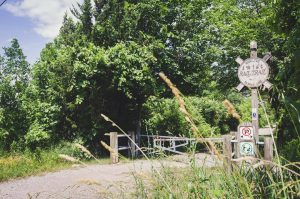Nature @ McMaster launches expanded website

Christie Lake Conservation Area. Photo by Adel Hashemi
On October 5, 1929 – a year before classes at McMaster were to start in Hamilton, but after folks in the city knew the university was on its way – the Hamilton Spectator waxed poetic about the school’s natural landscape:
“The new university starts with a plenitude of groves of Academe … right on the brink of a sylvan paradise. Its scholars will at their back door have cool ravines and marsh meadows in which to meditate the theological and other muses… And they will have red-winged blackbirds and whistling swans and canorous Canada Geese to keep them company.”
Ninety-one years later, the description is still true.
And luckily, there’s Nature @ McMaster’s newly expanded website to help students, staff, faculty and the community in Hamilton discover the many, many outdoor spaces both on and close to campus.

“We’re blessed in having such a broad scope of natural areas in and around the university – but lots of people don’t know about them, or how to get there,” explains Wayne Terryberry, McMaster’s coordinator of outdoor recreation and natural lands.
“It’s even more important now with COVID restrictions that we provide resources for people to become physically active and destress in nature – with Mac’s athletics and recreation facilities closed, people need other ways to get active.”
The website was created in 2016 to support Nature @ McMaster’s broader work in campus land and trail management, outreach, environmental stewardship, and classroom and outdoor learning programming.
One of its most popular parts of has been a comprehensive listing of outdoor areas on and around campus, incorporating information from the university, local conservation authorities, the City of Hamilton, the Royal Botanical Gardens and others.
Now, with McMaster’s fall and winter terms online and more people working and studying from home, Nature @ McMaster has expanded to provide info from organizations across Ontario, including the Ontario Trails Council, Ontario Parks and the Bruce Trail Conservancy – opening up the resource to serve a greater number of McMaster folk, no matter where they are.
The expanded website, which was shepherded by Arts and Science graduate and Nature @ McMaster lead Martha Kilian, health sciences student Gabrielle Christopher and political science student Elizabeth Marr, also provides a section on accessibility, which includes a list of accessible trails in Ontario, as well as information on borrowing McMaster’s Hippocampe All-Terrain Wheelchair.

As well, the site includes information on using a variety of transportation methods to access sites, including public transit, walking and biking – making the areas more accessible to those who don’t have a car.
Finally, there’s new info on courses at McMaster that incorporate an outdoor component, as well as a section dedicated to research on the connection between nature and health.
“It’s really important that, especially now, we highlight the research that shows the benefits of being in nature to learning, stress levels, overall health and cognition,” Christopher explains. “Students might not think that getting up and going for a walk is a good use of their time when they’re busy studying, but, in fact, it might be the best thing they can do.”
Kilian says that one of the most valuable things about the new website is how comprehensive it is – combining information from a multitude of organizations that’s otherwise spread across many different sites.
“It’s one of the few comprehensive resources on all the outdoor areas in our community,” she explains. “It’s an amazing resource to get outside and explore the incredible natural areas around us.”
Thinking of getting outside? Here are some favourite spots around campus:

“Cootes is so close to campus! The Chegwin Trail, which you can access behind Brandon Hall, has everything – a boardwalk, bird watching, skating in the winter, and it’s great if you’re close to campus but don’t have a car.” Martha Kilian

“I enjoy biking on the Hamilton-Brantford rail trail and connecting with the Dundas Valley – plus, it’s got great connectivity to student spots along Main West.” Gabrielle Christopher

“I love the McMaster Forest, which is in the Dundas Valley – it’s quiet, easy to access, and there’s actually some old-growth forest there, which makes it environmentally significant in this area. It’s also connected to the work of the university, with researchers doing fascinating work to restore native tree species.” Wayne Terryberry

